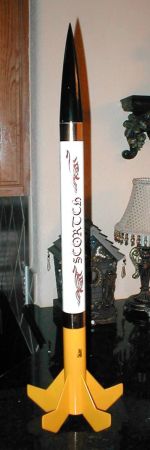| Construction Rating: | starstarstarstarstar |
| Flight Rating: | starstarstarstarstar |
| Overall Rating: | starstarstarstarstar |
| Manufacturer: | Red River Rocketry  |

Brief:
This is a BT-55 kit that flies on a 24mm motor and utilizes streamer recovery. The rocket looks spectacular against
the background of the kit art and doesn't lose a thing on the pad. Parts quality is excellent too, and John has even
included the spacer to allow the rocket to fly on D or E motors. Nice touch!
Construction:
The parts list:
- 1 BT-55 kraft main body tube
- 1 BNC-55 balsa nose cone
- 1 laser cut balsa fin sheet
- 1 3.75" x 24mm motor mount kit with motor clip
- 1 standard 1/8" launch lug
- 1 screw eye
- 2 washers, 1" steel (nose weight)
- 1 shock cord, 20" Kevlar® line plus 36" x 1/8" elastic
- 1 mylar streamer
- 1 decal sheet, water slide
- 2 gold monocote decorative strips
I test fit all the parts first and sanded for fit as needed, then sanded all the tubes and balsa and filled the nose cone using Elmer's Fill 'n' Finish to get that all out of the way in the beginning. The body tube seams were hardly noticeable so I didn't worry with filling them. The fins come in two pieces and are glued together first. Since the parts are laser cut, these fit together very nicely. While the fins are gluing the motor mount can be constructed, it is a standard build except the 20" Kevlar® line is added into the mix. The recommended method for installation of the Kevlar® line is neatly done, but I prefer to have the Kevlar® further up the tube so I can inspect it. So, instead, I made a standard paper shock cord attachment and used the Kevlar® with that. It's my own standard. After that, I filled the joints in the fins, re-sanded and then papered them.
Next, I inserted the motor mount into the tube. While that was drying, I cut the launch lug in half, glued the washers together first with J-B Weld and glued then onto the base of the nose cone. Then I inserted the screw eye, cut out the marking guide, and drew the alignment lines. I used double glue joints to attach the fins and launch lugs. The parts go on very nicely with this method and stay where you put them.
Once everything had dried, I added fillets to all of the joints. Lastly, the shock cord mount and shock cord was installed and connected to the screw eye in the nose cone. I put CA around the forward end of the tube and tied a knot in the Kevlar® at the exit point to protect against abrasion then added a loop in the Kevlar® to tie on the 1/8" elastic cord. Lastly, I put the parachute together.
Finishing:
I rounded the leading edges of the fins and lightly tapered the trailing edges first. The black nose cone was painted
separately from the white and yellow body tube before attaching the shock cord. After a couple of days drying time, I
masked off the body tube and painted the rear of the tube and fins yellow. If you mess up on the yellow/white paint
line, there are no worries as the Monokote will hide that. Sweet! The decals were cut out while waiting for the fins to
dry. I had problems putting on the decals. They were really thin and tore easily. I didn't get them where I wanted
them. They tore in two places trying to move them, so I let them stay where they lay. It still looks good. Next I
applied a couple of coats of Future floor wax to protect the finish and improve the shine.
Construction Rating: 5 out of 5

Flight:
Finally got a chance to fly at a DARS launch on our brand new Frisco field. I opted to use a D12-5 on the first
flight and then planned to fly on the E motor. The Scortch zoomed from the pad with minimal weathercocking even though
the winds were blowing between 8-12mph and reached some serious altitude. I would guess it reached close to 1,000 feet.
Recovery:
Popped the streamer right at the top. The streamer is a little short, but it stayed up longer than I was
anticipating. Broke a fin off on landing, so I didn’t get a chance to fly that E motor.
Flight Rating: 5 out of 5
Summary:
The Scortch is a quick, easy build. Parts quality is superb and the decals really enhance the look of the rocket. It
looks great displayed with the face card, too.
Pros: Fantastic looks, quick build, quality parts with laser cut fins, excellent instructions, and a nice long shock cord
Cons: The decals are thin. I made the change with the shock cord, but that is just personal preference.
Overall Rating: 5 out of 5
 |
 |
Flights
Sponsored Ads
 |
 |











